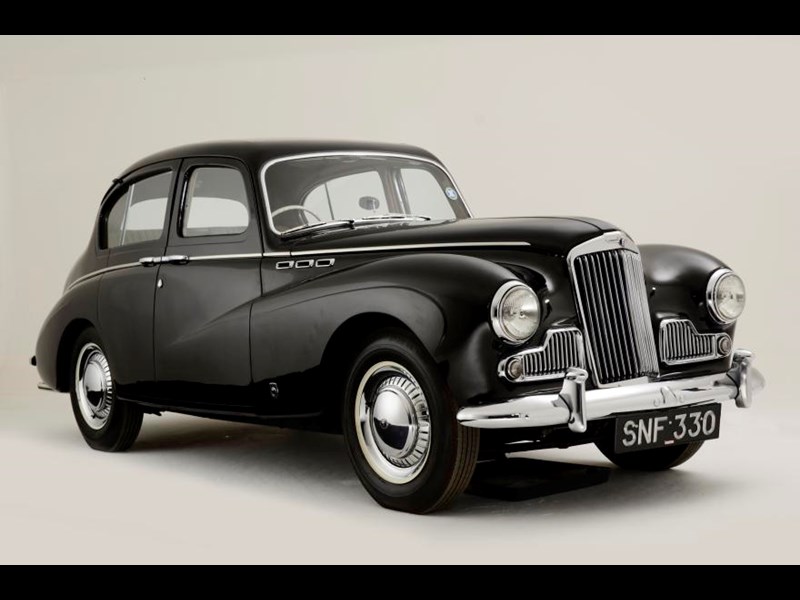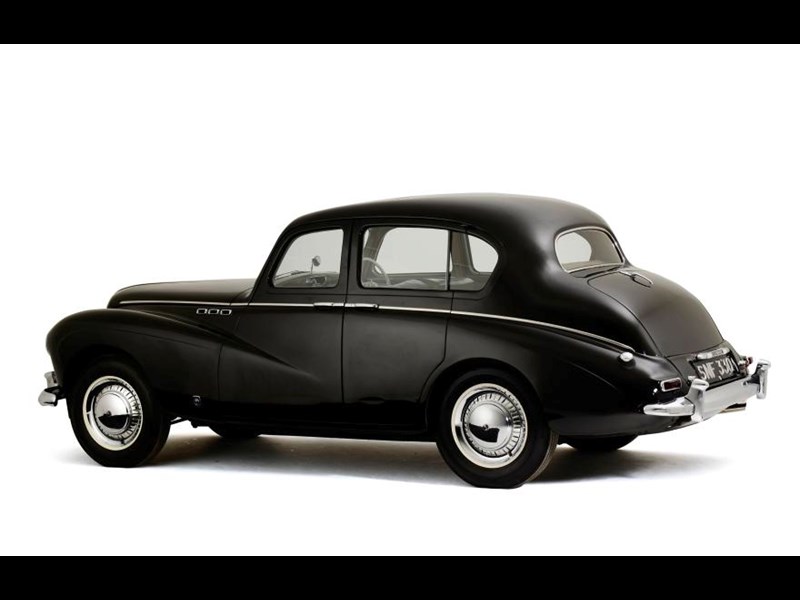In the late 1940s, the Sunbeam and Talbot names still had a sporting resonance despite ownership since 1935 by the rationalising Rootes Brothers. The first post-war cars were warmed-over 1930s types, but in June 1948 came genuine new models. Rootes stylist Ted White designed an elegant new body, somewhat let down by the resolutely pre-war mechanicals of the Sunbeam-Talbot 80 but much better as a 90 with a bigger engine in the same body.
The 90 came as a four-door saloon with a pillarless join between rear door and quarter-window, or as a four-seater drophead coupé. Both had rear wheel spats, and the 90 became one of the most successful rally cars of its time in the hands of drivers like Stirling Moss, Sheila Van Damm and Mike Hawthorn.
The first cars had a 1944cc OHV engine, uiltimately derived from a pre-war Humber side-valve type, and with 64bhp this delivered 75mph performance. The fashionable column-change gearbox didn't help acceleration, and the cart-sprung beam axles at both ends showed the age of the basic design.
From September 1950, the Sunbeam-Talbot 90 MkII brought a much better big-bore engine with 2267cc and 70bhp, plus a stronger chassis with a central cruciform brace, independent front suspension and Panhard rod location for the rear axle. Air intake grilles replaced the twin foglamps of the early cars, and headlamps were raised. This was the classic 90, capable of 86mph. There was a more powerful, 77bhp, version of the engine from October 1952, when the MkIIA models appeared. These had bigger brakes to cope, plus ventilated disc wheels, and they lost the rear wheel spats.
From 1954, the Talbot name was dropped, and the cars became Sunbeam MkIII types with air intake grilles embracing the sidelights, portholes in the bonnet sides, duo-tone paint options and an extra-cost overdrive that became almost standard. Drophead coupés went out of production in summer 1955, but the saloons continued until summer 1957. There were 4000 MkI cars, 5493 MkIIs, 10,988 MkIIAs and 2250 MkIIIs.
VITAL STATISTICS
Engine 2267cc/4-cyl/OHV
Power 77bhp@4100rpm
Torque 113lb ft@2400rpm
Top speed 85mph
0-60mph 21sec
Economy 22mpg
Gearbox 4-speed manual
WHAT TO LOOK FOR
GEARBOX
The gearbox is the weakest of the mechanical elements on these cars. It's an uprated Hillman Minx type, which was really only marginal for the job. Bottom gear has no synchromesh, but the teeth on both first and reverse gears can wear and protest loudly. If the gears jump out on the over-run, the synchromesh is probably worn; third gear suffers first. The Laycock overdrive on MkIII cars doesn't give much trouble, but if there are engagement problems, suspect a defunct solenoid. The final drive is a spiral bevel type on early cars, and its internal cage can break up; the MKII and later models have a hypoid unit.
ENGINE
The engines have pre-war origins, and were re-engineered with OHV after the war. They are under-stressed and reliable units that last for a long time between major overhauls – 100,000 miles is only normal by today's standards, but was good in the 1950s. A healthy engine has oil pressure of 40-50psi, and anything less than 30psi is cause for concern. One weakness that sometimes shows up is burnt exhaust valves, which seem to be less common on MkIII models. Spares availability for the engines is quite good.
CHASSIS
The chassis is tough, but you should check the forward hangers of the rear springs, which are mounted on outriggers. The outriggers themselves can rot, too. Examine the lowest point of the side-members, under the rear axle, where water can collect in the box-section and rot it through from the inside. Coil springs on the MkII and later cars can become tired, and the Armstrong lever dampers used on all models also wear. If the steering feels vague, suspect a worn idler (inadequate maintenance accelerates that wear). Less common, but possible on a car that hasn't been used for many years, is incorrect packing between the springs and front axle.
BRAKES
Brakes don't normally give cause for concern, and the good news is that some components were shared with other cars. In particular, the MkIII uses the same brake master cylinder as the early Morris Minor, while its wheel cylinders (larger than on earlier 90s) are shared with the Minor 1000.
BODYWORK
New panels haven't been available for years, and your only option will be to patch and repair what you have. The front wings bolt on, so they can be taken off to make repairs slightly easier. Starting at the front of the car, check those wings around the headlamps and wheelarches, and around the air intake grilles, especially on MkIIIs. Look at the back of the wing by the door. The doors themselves rot out at the bottoms, almost always because of blocked drain channels. On the rear wings, examine the front edges, the wheelarches and the lower rear sections. At the back end, rust attacks the neat recesses in the panels that are designed to accommodate the bumper.
Saloons have sunroofs, and their drain tubes can perish or block. The results are rust around the sunroof aperture and rust in the floorpan where water has accumulated. Check the sills, and the area where they join the floor sections. It's also worth examining the boot floor and the boot lid, which has a compartment where the tools are kept. It's almost superfluous to say that drophead coupés also suffer from rotten floorpans and sills; water has no problem getting inside the car, but some difficulty in getting out!
If you're very lucky, you might come across one of the 30 or 40 late MkIII cars uprated by Sunbeam dealer Castles of Leicester. Known as MkIIIS types, these have improved manifolding with a Stromberg D142 carburettor, and came with a Halda average speed recorder attached to the dashboard. Best of all, they also have a floor change – an aftermarket conversion that could also be bought from Castle's for retro-fit to other 90s.
OUR VERDICT
The drophead coupés are really pretty but more expensive than their saloon equivalents. None of these cars gives scintillating performance by modern standards, but there's a special satisfaction about driving them. Probably the best model to go for is a late MkIII with overdrive, but you might have to hunt quite hard to get what you want.


